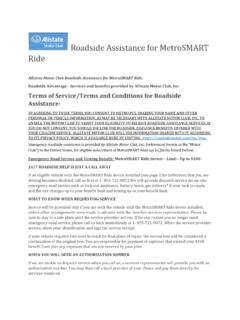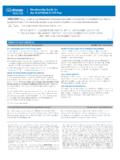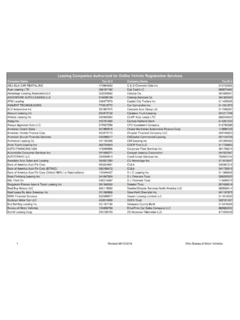Transcription of policies, and inter-policy stacking. - mcdas.com
1 THE BASICS OF UM/UIM COVERAGE. This Article addresses the basics of Underinsured (UIM) and Uninsured (UM). motorist coverage in North Carolina, and is outlined as follows: A. Examine the Details of Offering/Purchasing Coverage, Waiving Coverage and Selecting Limits B. Determine the Nature and Extent of UM and UIM Coverages C. Interpret Exclusions and Limitations on Coverage D. Offsets and Reimbursements E. Subrogation Rights of UM Carrier F. How the Statute of Limitations Applies A. Examine the Details of Offering/Purchasing Coverage, Waiving Coverage and Selecting Limits The selection of UM/UIM coverage typically begins with the insured communicating in some manner with his insurance agent.
2 Probably the most common method of selecting UM/UIM coverage and limits is where the insured ( named insured or policyholder ) purchases liability insurance, which is of course required to operate a motor vehicle in this state. Pursuant to the Financial Responsibility Act, unless the insured rejects this coverage (discussed below), the insured will receive UIM limits equal to his liability coverage under that policy (except for a minimum limits policy ) and he will receive UM coverage with limits equal to his liability limits. Therefore, the general rule is that the UM/UIM limits under a liability policy are equal to the limit of liability coverage afforded under that policy .
3 The insured may reject these UM/UIM limits. The insured would typically reject UM/UIM coverage to save money on the insurance premium. A subsequent section addresses issues of stacking UIM coverage on different policies , and inter - policy stacking . In order for the insured to effectively reject the statutory UM/UIM coverage, he must reject this coverage in a very specific manner. In particular, he must execute a selection/rejection form promulgated by the Rate Bureau. (b)(4). states: The coverage required under this subdivision [ UIM coverage] shall not be applicable where any insured named in the policy rejects the coverage.
4 An insured named in the policy may select different coverage limits as provided in this subdivision. If the named insured does not reject underinsured motorist coverage and does not select different coverage limits, the amount of underinsured motorist coverage shall be equal to the highest limit of bodily injury liability coverage for any one vehicle in the policy .. The FRA also states, Rejection of or selection of different coverage limits for underinsured motorist coverage for policies under the jurisdiction of the North Carolina Rate Bureau shall be made in writing by the named insured on a form promulgated by the Bureau and approved by the Commissioner of Insurance.
5 Id. Many cases have held that a selection/rejection form which does not strictly comply with the form of the Rate Bureau is insufficient to reject the mandatory coverage, generally resulting in more favorable UM/UIM coverage available to the insured. For example, where the form is written with a font which is too small, the form is ineffective. Erie Ins. Exchange v. Miller, 160 App. 217, 223, 584 857, 861 (2003) ( Erie offered no evidence that the Rate Bureau or the Commissioner of Insurance has authorized it to include the rejection/selection form in its application or to print it in tiny type. As Erie has failed to show that its modification of the Rate Bureau form was authorized or approved, it has failed to establish that the Millers validly rejected UIM.)
6 Coverage. ). Accord State Farm Mut. Auto. Ins. Co. v. Fortin, 350 264, 269, 513. 782, 784 (1999) ( We note first that the State Farm version of renewal form NC0186 that Bruce Fortin executed in January 1992 was not the form promulgated by the North Carolina Rate Bureau and approved by the Commissioner of Insurance.' We note further that the statute specifically provides that rejection shall be made in writing'. on the approved form. The State Farm renewal form required that the rejection be made, not in writing' on the form, but by contacting the State Farm agent. Thus, the rejection was not in accord with the statute.
7 In a case from 2005, the North Carolina Supreme Court held that where the UIM. carrier did not provide the insured with a right to select greater limits, that the insured was entitled to the maximum UIM limits of $1,000,000. Williams v. Nationwide Mut. Ins. Co., 174 App. 601, 603, 621 644, 645 - 646 (2005) ( A total failure on the part of the insurer to provide an opportunity to reject UIM coverage or select different UIM policy limits violates the requirement that these choices be made by the policy owner. Such a failure should not invoke the minimum UIM coverage limits established in (b)(4) and shield the insurer from additional liability ; even though liability limits were $50,000, he insured was entitled to $1,000,000 in UIM.)
8 Limits). Following this case, many insureds are requesting that the UIM carrier provide them with a copy (or even the original) of the actual selection/rejection form. There are many intricate twists in determining whether a particular policy provides UM/UIM coverage, and all of these scenarios cannot be addressed in this manuscript. For example, where the policy is a fleet policy (defined as insuring four or more vehicles), then the insurer is not required to use the Rate Bureau form. An insured's rejection of the coverage can be inferred from the insured's failure to select such coverage. Hlasnick v. Federated Mut. Ins.
9 Co., 136 App. 320, 323-325, 524. 386, 390, aff'd, 353 240, 539 274 (2000). In Hlasnick, the court held that the insured's selection of different limits for liability coverage and for UM/UIM. coverage was permissible, and that the insured thereby rejected additional UM/UIM. coverage. See also id. at 325, 524 at 389 (finding that insured rejected additional UM/UIM coverage even though the form used here contained no written notice to the insured of the option to reject underinsured coverage and consequently is deficient. ). Also, these mandatory UM/UIM requirements apply only to a motor vehicle policy of liability insurance which is certified as provided in or 20- as proof of financial responsibility.
10 It has been held, therefore, that an umbrella policy is not required to provide UM/UIM coverage, even though such a policy may provide automobile liability coverage. Progressive American Ins. Co. v. Vasquez , 350 386, 394-395, 515 8, 13 (1999) ( We do not find that , Isenhour, or public policy requires that an excess liability policy offer separate UM/UIM coverage in addition to what is provided by the underlying policy where there are two separate policies : an underlying, primary policy required by law under the Financial Responsibility Act and an excess liability policy voluntarily purchased by the insured to provide further protection from liability for the insured.)






